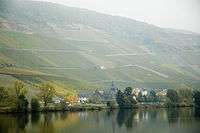Weingut Joh. Jos. Prüm
| Weingut Joh. Jos. Prüm | |
|---|---|
.jpg) | |
| Location | Bernkastel-Kues, Germany |
| Appellation | Mosel |
| Founded | 1911 |
| Key people | Dr Manfred Prüm, Wolfgang Prüm, Dr Katharina Prüm |
| Cases/yr | 10,000 |
| Varietal | Riesling |
| Website | http://www.jjpruem.com/ |
Weingut Joh. Jos. Prüm is a German wine grower and producer based in Bernkastel-Wehlen, in the wine-growing region of Mosel, Germany.
History
The Prüm family have had a presence in Wehlen for over 400 years. The estate was founded in 1911 by Johann Josef Prüm, after the splitting up of the S.A Prum winery.[1][2][3] In 1920, Johann Josef's son, Sebastian, started working for the estate. Robert M. Parker, Jr. says that the estate's reputation was largely built by Sebastian and that he "developed the distinct style of the Prum wines during the 1930s and 1940s".[4][5] Sebastian died in 1969 and his sons, Dr Manfred Prüm and his younger brother Wolfgang Prüm took over. Manfred has been working with his daughter Dr Katharina Prüm since 2003.[1][6][7] Manfred Prüm was named German Winemaker of the Year in 1996 by the Gault Millau Guide to German Wines.[8]
J.J. Prüm is a member of the Großer Ring Verband Deutscher Prädikats- und Qualitätsweingüter.[2]
Vineyards and wine


The estate has 14 acres of holdings in the Wehlener Sonnenuhr, Graacher Himmelreich, Bernkasteler Lay, Bernkasteler Badstube and Zeltinger Sonnenuhr vineyards. Only Riesling is grown and harvested at these sites by Joh. Jos. Prüm.[2] The most important of these sites are Wehlener Sonnenuhr and Graacher Himmelreich, in terms of both quantity and quality for the winery.[1][9] Seventy percent of the vines are ungrafted.[5]
Depending on the vintage, the average annual production is 10,000 to 13,000 cases of wine.[5]
Stuart Pigott says of J.J. Prum that "since the early 1920's its wines have been among Germany’s best Rieslings with the Mosel’s vivacious aroma and racy elegance in its highest form"[9] and wine writer Stephen Brook says that "The wines, whether a modest Kabinett or an opulent Beerenauslese, are the epitome of filigree elegance: light in body but intense in flavour, exquisitely balanced and precisely tuned, and capable of the most extra-ordinary longevity".[6]
References
- 1 2 3 Reinhardt, Stephan (2012). The Finest Wines of Germany. Aurum Press Ltd. pp. 234–236. ISBN 978-1-78131-021-2.
- 1 2 3 "Großer Ring – VDP Mosel Saar Ruwer". Grosserring.de. Retrieved 2013-03-31.
- ↑ "The Wine Doctor – Joh. Jos. Prum". Thewinedoctor.com. Retrieved 2013-03-31.
- ↑ Parker, Robert (2005). The World's Greatest Wine Estates. Simon & Schuster. pp. 441–442. ISBN 978-0-7432-3771-0.
- 1 2 3 "Rudi Wiest: J.J. Prüm Estate". Germanwine.net. Retrieved 2013-03-31.
- 1 2 Brook, Stephen (2006). The Wines of Germany. Mitchell Beazley. pp. 198–199. ISBN 978-1-84000-791-6.
- ↑ "A puzzle worth deciphering". The Age. Retrieved 2013-03-31.
- ↑ "Rudi Wiest:Gault Millau's Awards". Germanwine.net. Retrieved 2013-03-31.
- 1 2 Piggot, Stuart (1996). The Wine Atlas of Germany. Antique Collectors Club Ltd. pp. 54–55. ISBN 978-1-85732-625-3.
External links
Coordinates: 49°56′29″N 7°02′43″E / 49.941375°N 7.045412°E